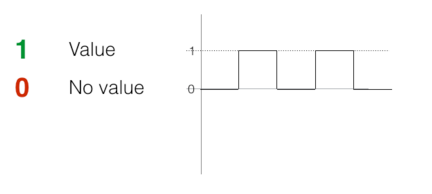Number System for State
Lab: Basics of Digitizing Data
Video Runtime: 12:44
This episode continues our discussion on the Basics of Digitizing Data. Let’s talk about a numbering system that represents state, i.e. on or off and one or zero. It’s an introduction to binary.
Your key takeaways are:
- 0 and 1 are the simplest digits
- 1 represents a value, e.g. on, go, present, all clear, etc.
- 0 represents no value, e.g. off, stop, absence, not clear, etc.
- Digital signal is 0 or 1
- Combine 1s and 0s to represent counts (numbers)
Study Noties
What is the simplest way to communicate in a numbering system?
Think about this: What are the simplest symbols, numbers, or digits?
How do we communicate state in our world?

To help us understand, let’s talk about how we communicate “state” in our world:
- ON or OFF
- Presence or Absence
- Go or No Go
- Clear or Not Clear
We use various language means to communicate a simplistic state.
How can we convert those visual representations for “state” into a numbering system? What are the symbols we can use?
Think in digits
Using the same graphics as before, we’ll attach the proper digits to the “state.”
If a state is “off,” how can that be represented? It has no value because it’s “off.” Therefore, it is a 0 digit. Conversely, if the state is “on,” then it has value. We can represent it as a 1 digit.
If something is present, it has value in contrast to not being present (or being absent.) Therefore, we can say that presence is represented by a 1 digit and absence is represented by a 0 digit.
Sum it up
 Our symbol, which is a digit 1, means it has a “value.” It’s “on,” “present,” “go,” “all clear,” and any other state meaning “yes.”
Our symbol, which is a digit 1, means it has a “value.” It’s “on,” “present,” “go,” “all clear,” and any other state meaning “yes.”
Our symbol, which is a digit 0, means it does not have a “value.” It’s “off,” “absence,” “stop,” or “not clear.”
Using our digital signal, we see that a 1 means the presence of electrical voltage—or power is flowing; whereas, a 0 means no power or electrical voltage is flowing.
Convert simple digits into a numbering system
In Decimal Number System
- 10 digits -> 0 to 9
- Base 10
- Collection of 10 items we can count
What do we know about our new numbering system?
- 2 digits -> 0 and 1
- Base ?
- Base 2
- Collection of 2 items we can count
In Decimal, we have 10 digits, or symbols. And we said that was a base 10, or a collection of ten items that we counted.
Here we only have two digits. 0 and 1
What base do we call it? If we called decimal base 10, what do we call this new numbering system? Base 2.
How many states can you represent with two digits?
Two
But we need more…
Pattern of 1s and 0s

These are patterns using a combination of 1s and 0s. We are going to walk through the patterns of decimal to bit and binary conversion. This is a preliminary to actually learning binary conversion.
You will grow in this profession when you incrementally and systematically stretch yourself....bit-by-bit.
Episodes
Total Lab Runtime: 02:59:07
- 1 Lab Introductionfree 03:56
- 2 Electronics “on” and “off” Statesfree 12:11
- 3 Symbol to Represent Quantityfree 14:26
- 4 Number System for Statefree 12:44
- 5 Binary – Combining 1s and 0sfree 19:25
- 6 Improving Binary Representationfree 13:45
- 7 The Age of 16 Bit and Hexadecimalfree 15:15
- 8 Binary Additionfree 03:59
- 9 Negative Integer Data Representation - Part 1free 10:06
- 10 Negative Integer Data Representation - Part 2free 18:42
- 11 Real Number Data Representation - Part 1free 17:12
- 12 Real Number Data Representation - Part 2free 10:18
- 13 Textual Data Representationfree 08:47
- 14 Digital Image Data Representationfree 18:21
